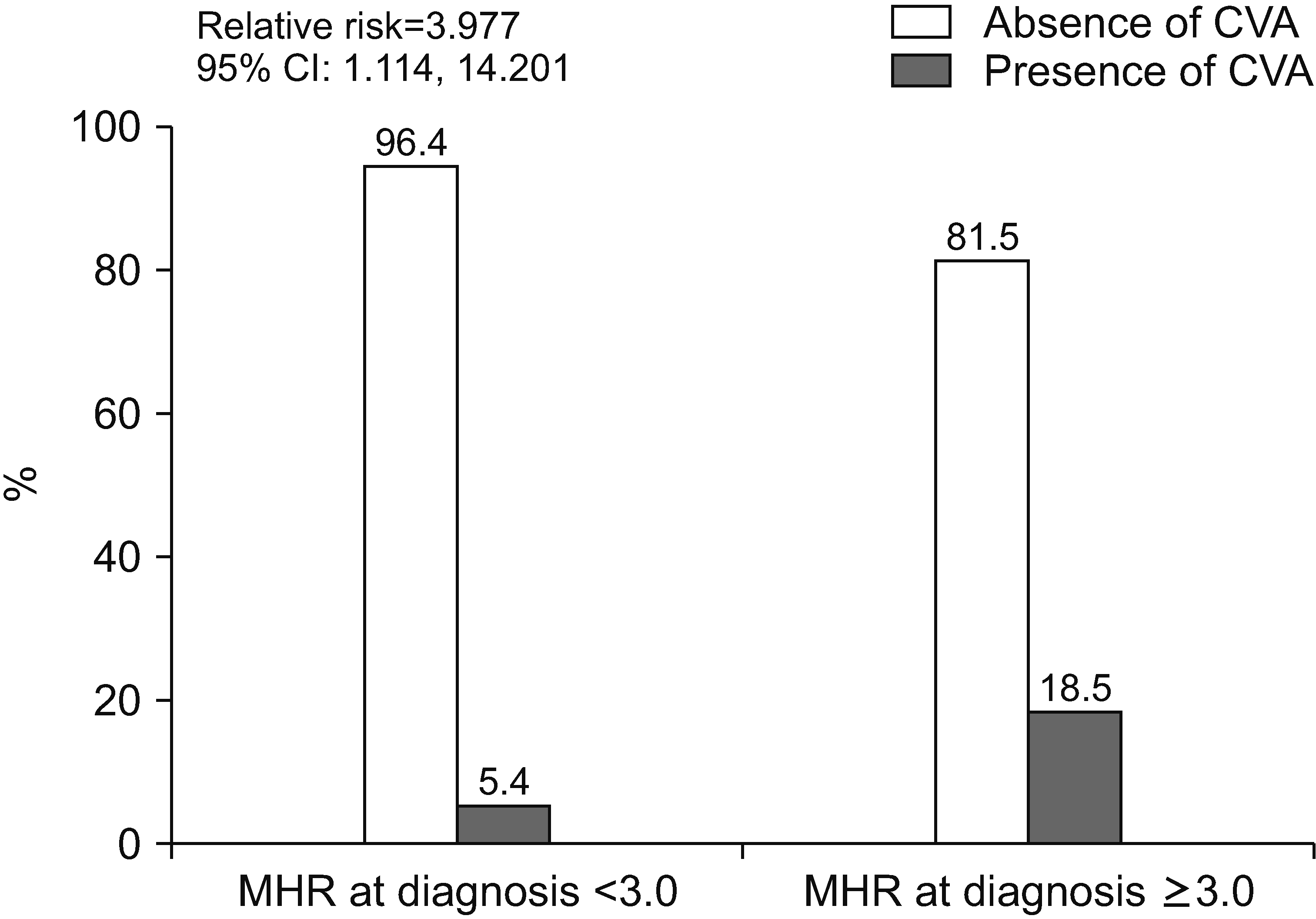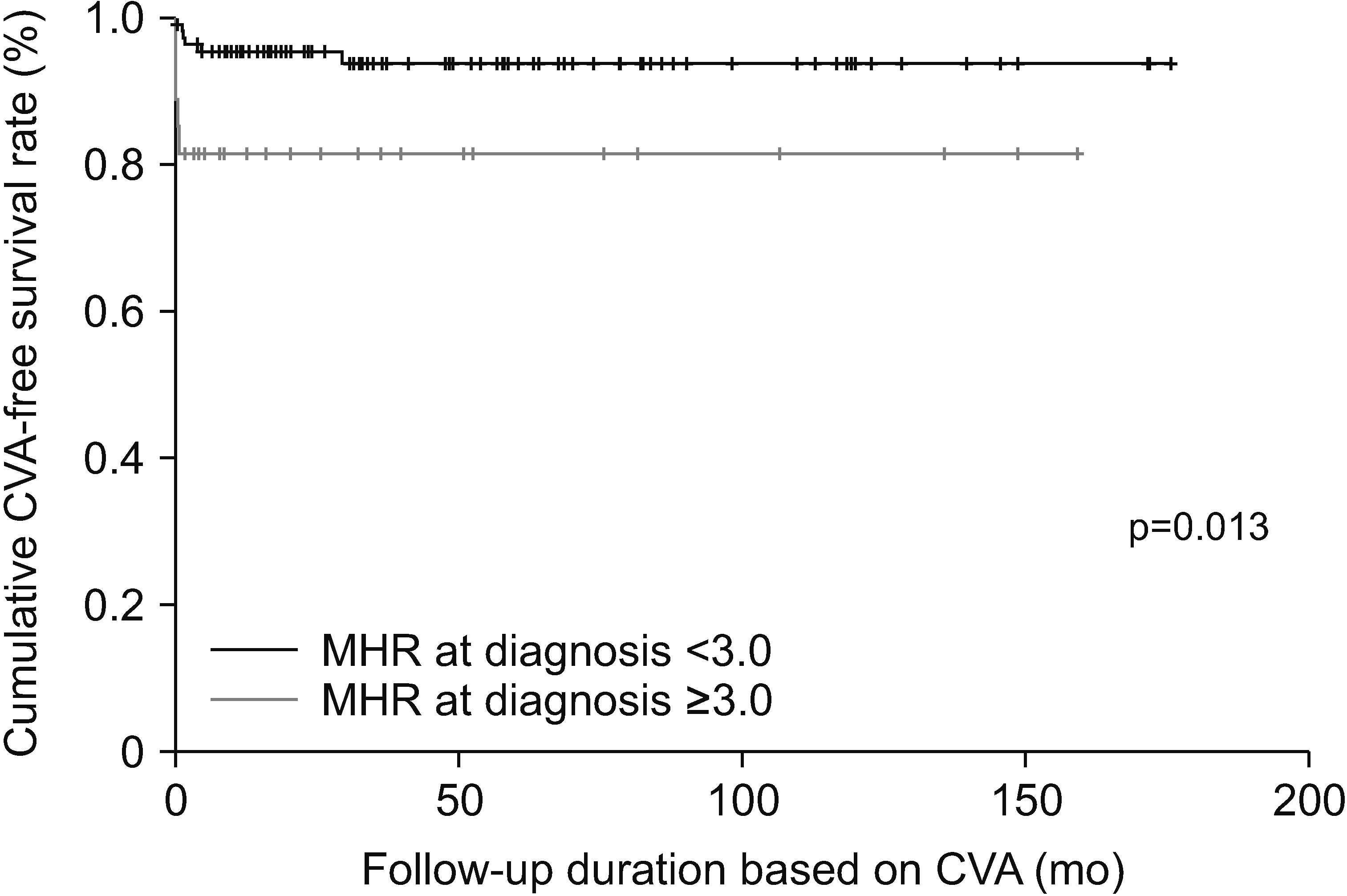INTRODUCTION
Antineutrophil cytoplasmic antibody-associated vasculitis (AAV) is a small vessel vasculitis that affects the capillaries, arterioles, venules, and occasionally medium-sized arteries [
1]. Based on the clinical features, AAV is categorized into three subtypes, microscopic polyangiitis (MPA), granulomatosis with polyangiitis (GPA), and eosinophilic granulomatosis with polyangiitis (EGPA) [
1,
2]. Although clinical symptoms vary depending on AAV subtypes, theoretically, AAV can induce inflammation in almost any organ, leading to atherosclerosis-related poor outcomes of AAV including all-cause mortality, and cerebrovascular and cardiovascular diseases [
3,
4]. Therefore, discovering initial risk factors to predict poor outcomes of AAV could have clinical implications.
Recently, the monocyte-to-high-density lipoprotein-cholesterol ratio (MHR) was introduced, and MHR at diagnosis or study entry was reported to be associated with all-cause mortality, acute coronary syndrome (ACS), and atherosclerosis [
5-
7]. However, the predictive ability of MHR at diagnosis for atherosclerosis-related poor outcomes of AAV in patients with AAV has not been reported to date. Given the need to discover various predictors for poor outcomes of AAV [
8], in this study, we investigated whether MHR at diagnosis might be associated with atherosclerosis-related poor outcomes of AAV during follow-up in patients with AAV.
MATERIALS AND METHODS
Patients
This study included 138 patients with AAV according to the following inclusion criteria: i) patients for whom diagnosed with MPA, GPA, and EGPA at the tertiary university hospital from November 2016 to March 2023; ii) patients who fulfilled the 2007 European Medicine Agency algorithm for AAV, the 2012 revised Chapel Hill Consensus Conference nomenclature of vasculitides, and the 2022 American College of Rheumatology/European Alliance of Associations for Rheumatology classification criteria for MPA, GPA, and EGPA [
1,
2,
9-
12]; iii) patients for whom medical records included clinical, laboratory, radiological, and histological data sufficient for confirming the classification of AAV as well as collecting information on AAV-specific indices and acute-phase reactants such as the Birmingham vasculitis activity score (BVAS), the five-factor score (FFS), erythrocyte sedimentation rate (ESR), and C-reactive protein (CRP) levels at diagnosis; iv) patients for whom medical records included monocyte counts and high-density lipoprotein cholesterol (HDL-cholesterol) levels at diagnosis; v) patients who were followed up for ≥6 months after AAV diagnosis and for whom atherosclerosis-related poor outcomes of AAV were clearly recorded; vi) patients who did not have concomitant malignancies or serious infectious diseases at diagnosis; vii) patients who had not received glucocorticoids at a dose of ≥10 mg/day equivalent to prednisolone, or immunosuppressive drugs within at least 4 weeks before AAV diagnosis.
Ethical disclosure
This study was approved by the Institutional Review Board (IRB) of Severance Hospital (Seoul, Korea; IRB No. 4-2020-1071). The requirement for additional written informed consent was waived by the IRB owing to the retrospective nature of this study and the use of anonymized patient data.
Data at diagnosis
Demographic data included age, sex, body mass index, and smoking history. The AAV subtype, antineutrophil cytoplasmic antibody (ANCA) type and positivity, AAV-specific indices, and laboratory results, including ESR, CRP, monocyte counts, and HDL-cholesterol were collected. Hypertension and type 2 diabetes mellitus were also recorded as initial comorbidities.
Data during follow-up
Atherosclerosis-related poor outcomes of AAV included three atherosclerosis-related systemic complications, namely, all-cause mortality, cerebrovascular accident (CVA), and ACS. CVA and ACS that had occurred before AAV diagnosis were not considered the poor outcomes of AAV in this study and were not counted. For patients with each poor outcome, the follow-up duration based on the corresponding poor outcome was defined as the period between AAV diagnosis and the time of the corresponding poor outcome occurrence. Whereas, for patients not having each poor outcome, the follow-up duration was defined as the time between AAV diagnosis and the last visit. Additionally, lipid-lowering agents, aspirin, antihypertensive drugs, and immunosuppressive drugs administered during follow-up were recorded.
Monocyte-to-high-density lipoprotein-cholesterol ratio
MHR was obtained by dividing monocyte counts (/mm
3) by HDL-cholesterol (mg/dL) levels [
6].
Statistical analysis
All statistical analyses were performed using SPSS Statistics for Windows, version 26 (IBM Corp., Armonk, NY, USA). Continuous and categorical variables are expressed as medians with 25th to 75th quartiles and numbers (percentages). The correlation coefficient (r) between the two variables was obtained by performing the Pearson correlation analysis. The multivariable Cox hazard model analysis using variables with statistical significance in the univariable Cox hazard model analysis was conducted to appropriately obtain the hazard ratios (HRs) during the considerable follow-up duration. Significant differences between the two categorical and continuous variables were compared using the chi-square and Fisher’s exact tests, and the Mann–Whitney U test, respectively. The cut-off value of MHR for a poor outcome was extrapolated by performing receiver operating characteristic (ROC) curve analysis. The relative risk (RR) of the cut-off value of MHR at diagnosis for CVA during follow-up was analyzed using contingency tables and the chi-square test. The cumulative survival rates between the two groups were compared using the Kaplan–Meier survival analysis with the log-rank test. Statistical significance was set at p-values <0.05.
DISCUSSION
In this study, the association between MHR at diagnosis and atherosclerosis-related poor outcomes of AAV during follow-up in patients with AAV was investigated, with several interesting findings. First, MHR at diagnosis reflected the cross-sectional activity of AAV and inflammatory burden. Second, among the three atherosclerosis-related poor outcomes of AAV, a significant and independent association between MHR at diagnosis and CVA during follow-up was identified using the univariable Cox analysis. Third, patients with MHR at diagnosis >3.0 had a significantly higher risk of CVA during follow-up and exhibited a significantly lower cumulative CVA-free survival rate than those without. Therefore, we conclude that MHR at diagnosis can be a useful index for predicting CVA during follow-up in patients with AAV.
Some reports suggested that MHR could be predictive of the development and progression of atherosclerosis, leading to the subsequent occurrence of cardiovascular and cerebrovascular diseases. Particularly, increased monocyte counts were associated with an elevated risk of cardiovascular disease [
13]. Additionally, MHR could be a significant indicator of the extent of carotid arterial plaques [
7] and might have predictive capabilities for ischemic stroke and related complications [
14,
15]. Therefore, previous studies reporting the association between MHR and the occurrence of atherosclerosis might support our findings, suggesting that MHR at diagnosis has an independent association with CVA during follow-up in patients with AAV. However, acknowledging that AAV-specific situations may introduce factors beyond typical causality, we present several following hypotheses.
First, MHR at diagnosis was significantly correlated with the cross-sectional BVAS, ESR, and CRP levels (
Figure 1). Systemic inflammation might lead to the initiation and acceleration of atherosclerosis, which could provoke the development of CVA and ACS [
16]. The link between CRP and atherosclerosis has also been established [
17], and in this study, BVAS at diagnosis was also correlated with the cross-sectional ESR (r=0.242, p=0.005), and CRP (r=0.226, p=0.008). Additionally, compared to that in the general population, patients with AAV are known to have a higher risk of stroke [
18]. Therefore, we hypothesize that MHR at diagnosis might reflect the cross-sectional AAV activity and inflammatory burden, which could sequentially augment the likelihood of CVA during follow-up through the onset and progression of atherosclerosis in patients with AAV.
Second, MHR at diagnosis was significantly correlated with age at diagnosis (r=0.176, p=0.039); however, neither monocyte counts nor HDL-cholesterol levels were correlated with age at diagnosis. Therefore, although MHR might not account for a large proportion, given that age is a significant risk factor for stroke [
19], we hypothesize that MHR at diagnosis could be used to predict CVA during follow-up in patients with AAV by reflecting the age at diagnosis.
Third, in the multivariable Cox analysis, MHR at diagnosis rather than BVAS, ESR, CRP, or age at diagnosis was a significant and independent indicator that was predictive of CVA during follow-up in patients with AAV (
Table 2). This suggests that another associated mechanism could exist other than those suggested in the first and second hypotheses. Given that serum albumin at diagnosis was also independently associated with CVA during follow-up and that monocyte recruitment can be promoted during inflammation [
20], we hypothesize that MHR at diagnosis might reflect the total amount of inflammation, which is more closely related to the development of CVA during follow-up in patients with AAV than BVAS, ESR, or CRP levels at diagnosis.
On the other hand, to investigate the statistical significance of the four cholesterol-related variables at diagnosis for predicting CVA during follow-up, we performed the univariable Cox analysis using these variables. We found that total cholesterol (HR: 0.991; 95% CI: 0.976, 1.006), low-density lipoprotein cholesterol (HR: 0.008; 95% CI: 0.983, 1.014), and triglyceride (HR: 1.000; 95% CI: 0.990, 1.010) were not associated with CVA, whereas HDL-cholesterol (HR: 0.948; 95% CI: 0.909, 0.989) exhibited an inverse predictive potential for CVA. When we, however, included HDL-cholesterol in the multivariable Cox analysis, we witnessed the statistically independent association of MHR (HR: 1.147; 95% CI: 0.973, 1.351) with CVA disappeared along with HDL-cholesterol (HR: 0.986; 95% CI: 0.944, 1.030), CRP (HR: 0.999; 95% CI: 0.987, 1.011), and serum albumin (HR: 0.261; 95% CI: 0.067, 1.013) at all. Nevertheless, given the well-known protective effect of HDL-cholesterol on CVA as well as the multicollinearity between HDL-cholesterol and MHR due to their high correlation, we conclude that it would be better not to include HDL-cholesterol in the Cox analyses to evaluate the clinical implication of MHR independently in the present study.
This study had certain limitations. The number of patients was not sufficient to represent all Korean patients with AAV, and thus, the results of this study cannot be immediately applied to patients in real clinical settings. The retrospective study design did not enable the serial measurements of MHR or the detection of subclinical CVA. Furthermore, the accurate incidence of vascular complications other than death, CVA, and ACS, such as deep vein thrombosis or thrombotic microangiopathy could not be investigated and provided because of the limitation of a retrospective study design. Nevertheless, this study had an advantage in that it was the first to demonstrate that MHR at diagnosis is independently associated with CVA during follow-up in patients with AAV. This study had another advantage in that it did not propose this cut-off of MHR at diagnosis as an absolute value but suggested a method to obtain the cut-off using the ROC curve for each cohort. A future prospective study with more patients will reliably reveal the dynamic clinical implications of MHR at diagnosis for predicting CVA during follow-up in patients with AAV.







 PDF
PDF Citation
Citation Print
Print



 XML Download
XML Download